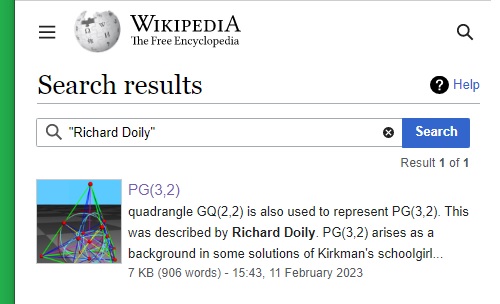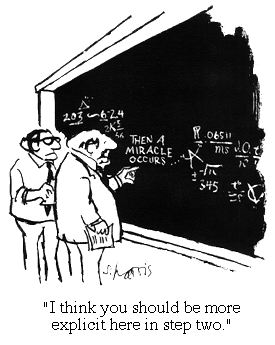

See also Doily in this journal.
Stanley E. Payne and J. A. Thas in 1983* (previous post) —
“… a 4×4 grid together with
the affine lines on it is AG(2,4).”
Payne and Thas of course use their own definition
of affine lines on a grid.
Actually, a 4×4 grid together with the affine lines on it
is, viewed in a different way, not AG(2,4) but rather AG(4,2).
For AG(4,2) in the proper context, see
Affine Groups on Small Binary Spaces and
The Galois Tesseract.
* And 26 years later, in 2009.
Wikipedia on what has been called “the doily” —
“The smallest non-trivial generalized quadrangle
is GQ(2,2), whose representation* has been dubbed
‘the doily’ by Stan Payne in 1973.”
A later publication relates the doily to grids.
From Finite Generalized Quadrangles , by Stanley E. Payne
and J. A. Thas, December 1983, at researchgate.net, pp. 81-82—
“Then the lines … define a 3×3 grid G (i.e. a grid
consisting of 9 points and 6 lines).”
. . . .
“So we have shown that the grid G can completed [sic ]
in a unique way to a grid with 8 lines and 16 points.”
. . . .
“A 4×4 grid defines a linear subspace
of the 2−(64,4,1) design, i.e. a 4×4 grid
together with the affine lines on it is AG(2,4).”
A more graphic approach from this journal —
Click the image for further details.
* This wording implies that GQ(2,2) has a unique
visual representation. It does not. See inscape .
See “Unfolded.jpg” in this journal. From that search —
Compare and contrast these figures with images by Wittgenstein in . . .
Related material from last night’s post Modernist Cuts —

Schlick also appears in recent posts tagged Moriarty Variations.

The 35 small squares between the pyramid and the pentagon
in the above search result illustrate the role of finite geometry
in the Miracle Octad Generator of R. T. Curtis.

Powered by WordPress